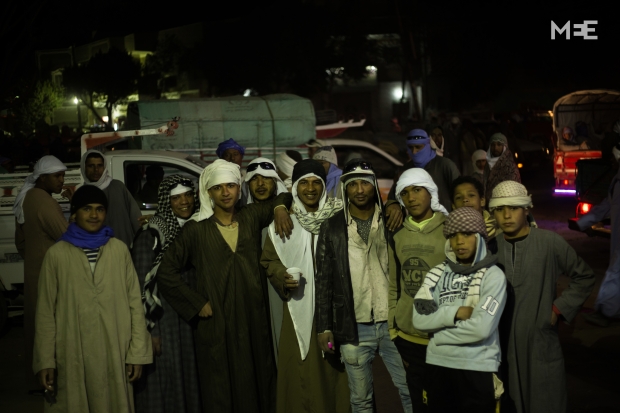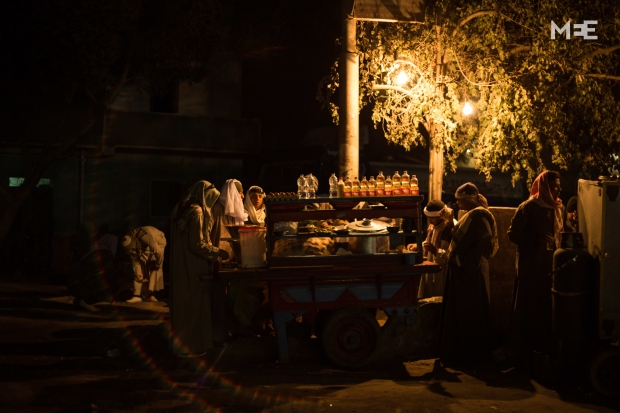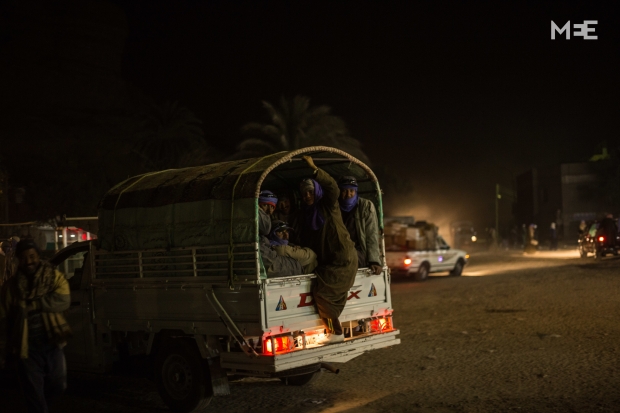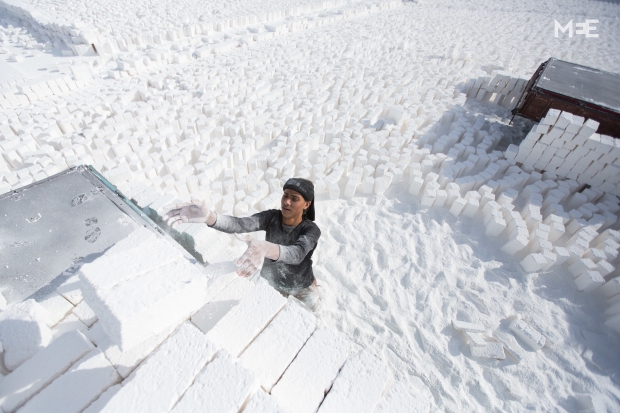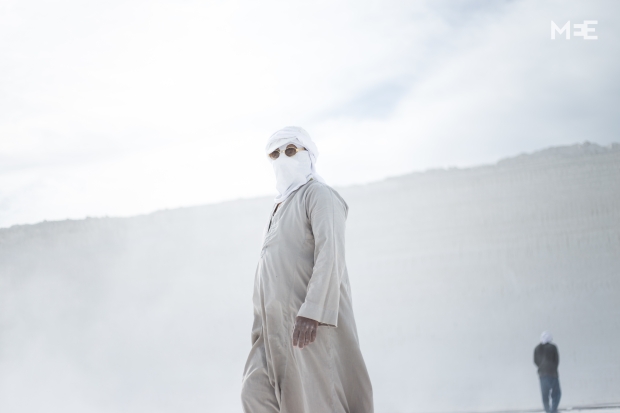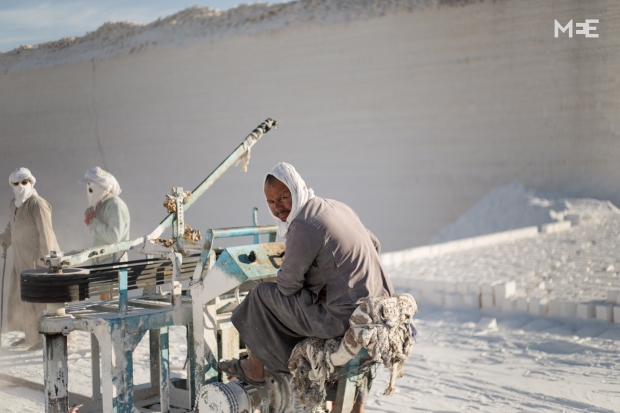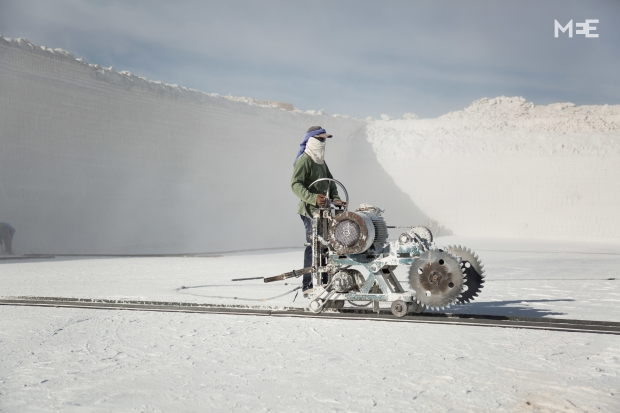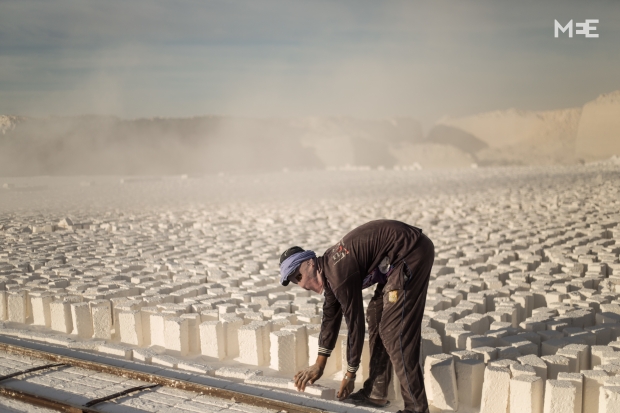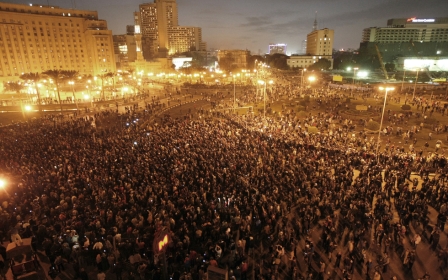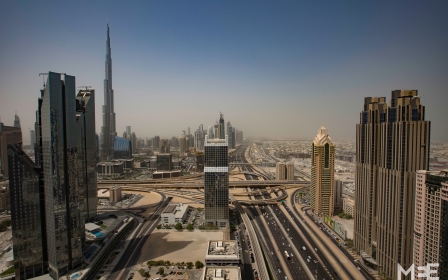Gasping for air: The dust-choked world of Egypt's quarry workers
For the labourers and children who work in Egypt's limestone quarries, the risk of respiratory illness and amputation go with the job

Workers at the limestone quarry job wear protective home-made masks that provide limited protection from dust (MEE/Belal Dardar)
Published date: Vendredi 4 mars 2016 - 12:29
|
Last update: 8 années 8 mois ago
Far away from the bustling streets of Cairo, in a snow-white world in Upper Egypt, labourers are hard at work at a job in which the risk of losing a limb or contracting a respiratory illness is very real.
The life for labourers in Egypt’s limestone quarries is intense and risky.
Their day starts before the sun even begins to rise. At about 3am, the labourers gather in the sleepy foothills of a mountain east of the Nile waiting for the cars that will drive them up through the curvy, dangerous mountain roads to the quarries.
They kill time waiting for the cars by chatting and trying to get warm by the fire in the chill of the pre-dawn morning, or by grabbing a quick bite to eat for breakfast from one of the many vendors in the area who are up as early as they are.
The journey lasts for around 20 minutes as the cars wind their way precariously through the twisting and jagged mountain roads.
The journey itself is extremely risky as the cars are not equipped to traverse the uneven roads and they are usually overloaded, often with more than 20 labourers per vehicle.
According to Alla al-Dakhly of the Quarry Worker Syndicate, there are about 300 limestone quarries in Minya and more than 20,000 labourers who work there.
The labourers are usually from surrounding villages and come from all walks of life. Farmers, college students and recent graduates all turned to the quarries in large numbers in the period following the 2011 revolution because of high unemployment rates that just seemed to keep growing due to the political turmoil the country was going through.
The average income at the quarries is between 80 to 100 Egyptian pounds per day, which is equivalent to about $10 to $13. While it might not seem like a lot of money to do such an exhausting and risky job, it is a relatively good wage when compared to being a farmer or being unemployed altogether.
Mohamed Ahmed Abo Ghanima, a 23 years old graduate from Minya university explained how he got into this line of work. “I started working in the quarries in my second year in college, to pay the expenses of my studies and to save a little money to get married. I honestly thought it would be a temporary period of my life” he continues. “I couldn’t find a job. I studied media, what is my chance to find a job in Minya, a forgotten governorate in Upper Egypt? I had no choice but to resort to the quarries.”
Unemployment is a real prospect facing many in the region if they do not take on this sort of physical labour. For struggling families needing desperately to raise their overall household income, many have no choice but to resort to sending their children to work in the quarries.
The sorts of roles the children are given include flipping bricks and loading cars. However, they are not officially employed by the quarry owner, so they only get half the wage that an adult would make, despite being exposed to the same environment and many of the same risks.
For all quarry workers the work itself is extremely dangerous. Clouds of dust rise, refusing to dissipate, blocking vision and making it hard to breathe. In a desperate attempt to make breathing easier, labourers often wear homemade masks fashioned from old pieces of cloth even in the sweltering heat, yet they are only of limited use.
The continuous exposure to the heavy dust can have a hugely detrimental impact on the labourers’ lungs resulting in many diseases in the long term.
The equipment used to cut the rocks into brick shapes are usually old, rusty and unsheathed, as the quarry owners are reluctant to spend more money buying modern, and much safer equipment.
One specific piece of key equipment is an electronic machine with two serrated metal blades used to cut through the hard white limestone rocks. A recurring accident in the quarries is when one or both of the metal pieces suddenly detach from the machine while working. The result has led to injuries including loss of limbs.
Getting decent monetary compensation is not always possible and filing an official case at the police station can result in a case being dragged out in court for years. A prospect that the family of the injured can rarely afford.
Alla al-Dakhly of the syndicate comments: “When an injury occurs, the quarry owner pays the family two or three visits, provides a car for them to transport the injured worker to the hospital and pays for the treatment,” he says. “People here are simple; after all of that, when they are offered 20,000 pounds (about $3,000) they often have no option but to gratefully accept.”
Things started to change in the quarries last May when the government applied an old law that was annulled and had not been in use for the last 60 years. It forces the quarry owners to pay six times the tax they already pay the government. Publicly the reason is to aid the government’s quest to find new sources of income, as Egypt’s budgetary crisis keeps deteriorating under Sisi’s rule.
However, the workers themselves have their own interpretation for this sudden decision. Abd al-Aati Hamada, a 41-year-old farmer who started working in the quarries five years ago for the extra cash he makes there, had his own religious perspective about this issue. “Allah is punishing the greedy owners for their mistreatment of the poor labourers.” He then quotes Prophet Muhammed’s saying: "The things that befall you are the result of your own actions."
Others believe that there is another and more practical reason behind the government’s decision. At least 50 percent of the quarries were forced to shut down with their owners offering them for sale as a result of their inability to pay the new tax.
The buyer for these quarries was the army, according to Tarek abd al Baset, a 29-year-old worker, who said: “The army had this deal with Ibrahim Mahlab, the former prime minister. He would simply raise the tax so that the owners would be forced to sell the quarries to the army, who of course don’t pay any taxes.”
Middle East Eye propose une couverture et une analyse indépendantes et incomparables du Moyen-Orient, de l’Afrique du Nord et d’autres régions du monde. Pour en savoir plus sur la reprise de ce contenu et les frais qui s’appliquent, veuillez remplir ce formulaire [en anglais]. Pour en savoir plus sur MEE, cliquez ici [en anglais].


